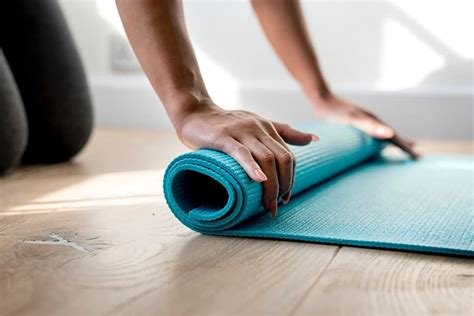How to Choose the Best Yoga Mat for Your Practice: A Comprehensive Review
As a yoga enthusiast, one of the most important decisions you’ll make is choosing the right yoga mat for your practice. The yoga mat plays a crucial role in providing stability, support, and comfort during your yoga sessions. With so many options available in the market, it can be overwhelming to find the best yoga mat that suits your needs. In this comprehensive review, we will delve into the importance of a yoga mat, the factors to consider before making a purchase, the different types of yoga mats and their features, as well as comparing the durability and longevity of various options. We will also explore finding the right thickness and texture for your specific needs, and the importance of considering eco-friendly options. Additionally, we will provide reviews and recommendations for some of the best yoga mats available, ensuring that you can make an informed decision in selecting the perfect mat for your practice.
Understanding the Importance of a Yoga Mat
Yoga mats are an essential tool for any yoga practitioner, as they provide a stable and comfortable surface for practicing various yoga poses and exercises. The importance of a yoga mat cannot be underestimated, as it not only helps prevent slipping and injury during practice but also provides a personal space for the practitioner to focus and connect with their body and mind.
When choosing a yoga mat, it’s important to consider factors such as thickness, texture, and durability to ensure that it meets your specific needs and preferences. A good yoga mat can enhance the overall yoga experience, allowing for better stability, alignment, and comfort during practice.
Furthermore, using a yoga mat can also have hygienic benefits by providing a barrier between the practitioner and the floor, preventing direct contact with sweat, dirt, or germs. This can be particularly important for those who regularly practice yoga in shared or public spaces.
In conclusion, understanding the importance of a yoga mat goes beyond just having a comfortable surface to practice on. It plays a crucial role in enhancing the overall yoga experience, promoting safety and stability during practice, and maintaining hygiene. Therefore, investing in a high-quality yoga mat that meets your specific needs is essential for any dedicated yoga practitioner.
Factors to Consider Before Choosing a Yoga Mat
When choosing a yoga mat, there are several important factors to consider to ensure that you find the perfect one for your practice. One of the most crucial factors to consider is the thickness of the mat. A thicker mat provides more cushioning and support for your joints, making it ideal for those with sensitive knees or wrists. On the other hand, a thinner mat may be preferred by those who prioritize portability and stability in their practice. It’s important to think about your specific needs and preferences before making a decision.
Another key factor to consider is the material of the yoga mat. Most mats are made of PVC, which is durable and provides excellent grip. However, if you prefer a more eco-friendly option, there are mats made from natural rubber, jute, or organic cotton. These materials are biodegradable and have a smaller environmental impact. Additionally, they often provide a natural texture that can enhance your yoga practice.
It’s also important to think about the texture of the mat’s surface. Some yogis prefer a smooth, sticky surface for better grip, while others may prefer a textured surface for added traction. Consider the types of poses you practice and the amount you sweat during your practice to determine the best texture for your needs. Your mat’s texture can significantly impact your overall experience and performance.
Finally, before making a decision, it’s essential to consider the price of the yoga mat. While it’s important to invest in a quality mat that meets your needs, it’s also crucial to find one that fits within your budget. Fortunately, there are options available at various price points, so you can find a high-quality mat that meets your needs without breaking the bank.
Different Types of Yoga Mats and Their Features
There are several types of yoga mats available in the market, each with its own unique features and benefits. The most popular type is the basic PVC mat, which is known for its affordability and durability. These mats are easy to clean and offer good grip, making them a great choice for beginners. On the other hand, natural rubber mats are eco-friendly and provide excellent cushioning and support. They are perfect for those who are looking for a more sustainable option. Another popular type is the jute yoga mat, which is made from natural fibers and offers a good grip and traction. These mats are also biodegradable, making them an environmentally friendly choice.
In addition to these, there are also other types of yoga mats such as travel mats, which are lightweight and easy to carry around, and extra thick mats, which provide added cushioning for those with joint pain or injuries. Cork yoga mats are another option, known for their antimicrobial properties and natural texture. These mats are perfect for those looking for a more natural feel. For those who are looking for a more luxurious option, there are also suede yoga mats, which offer a soft and velvety surface, providing a more comfortable and luxurious experience.
When choosing a yoga mat, it is important to consider the features that are most important to you. Whether it’s grip, cushioning, sustainability, or portability, there is a mat that is perfect for your needs. By understanding the different types of yoga mats and their features, you can make an informed decision and find the perfect mat to enhance your yoga practice.
It’s important to keep in mind that the type of yoga mat you choose can greatly impact your practice, so take the time to research and consider the features that matter most to you. Whether you’re a beginner or an experienced yogi, there is a yoga mat out there that is perfect for you.
Comparing the Durability and Longevity of Yoga Mats
When investing in a yoga mat, it’s essential to consider its durability and longevity. A durable yoga mat will withstand regular use and maintain its quality over time, making it a worthwhile investment for your practice. Longevity is also crucial, as you want a yoga mat that will hold up through numerous yoga sessions without deteriorating.
One factor to consider when comparing the durability of yoga mats is the material used. Some common materials include PVC, rubber, and TPE. PVC mats are known for their durability and are typically long-lasting, while rubber mats offer excellent grip and resilience. TPE mats are eco-friendly and durable, making them a popular choice for environmentally-conscious yogis.
In addition to material, the thickness of a yoga mat can also affect its durability and longevity. Thicker mats are often more durable and can withstand daily use without wearing down quickly. However, it’s essential to find a balance, as excessively thick mats may be heavier and less portable, impacting their longevity in different ways.
Another aspect to consider when comparing the durability and longevity of yoga mats is their maintenance and care. Proper cleaning and storage can significantly impact the lifespan of a yoga mat. Mats that are easy to clean and maintain are more likely to remain durable over time, providing a reliable foundation for your practice.
Finding the Right Thickness and Texture for Your Needs
When it comes to choosing a yoga mat, one of the most important factors to consider is the thickness and texture that will best suit your needs. The right thickness and texture can greatly impact your comfort and stability during your yoga practice, so it’s crucial to take the time to find the perfect fit for you.
First, let’s talk about thickness. A thicker yoga mat provides more cushioning and support, which can be beneficial for those with joint pain or who prefer a softer surface to practice on. On the other hand, a thinner mat offers more stability and a firmer grounding, making it ideal for those who prefer to feel closer to the ground during their practice.
Next, let’s consider texture. The texture of a yoga mat can vary from smooth to grippy, and each has its own benefits. A smooth mat allows for easy movement between poses, while a grippy mat provides added traction and prevents slipping, making it ideal for hot yoga or intense workouts.
Ultimately, finding the right combination of thickness and texture for your needs is a personal choice, and it may require some trial and error to find the perfect match. It’s important to consider your body’s needs and the type of yoga you practice when making your decision, and don’t be afraid to test out a few different options before making your final choice.
Considering Eco-Friendly Options in Yoga Mats
When it comes to choosing a yoga mat, many people focus on factors like thickness, texture, and durability. However, it’s important to also consider the environmental impact of the mat. Eco-friendly options provide a sustainable alternative that minimizes harm to the environment.
One key aspect to consider when looking for an eco-friendly yoga mat is the material it is made from. Materials such as natural rubber, organic cotton, or jute are biodegradable and renewable, making them a more sustainable choice compared to traditional PVC mats that are harmful to the environment.
In addition to the materials used, it’s important to also consider the production process of the yoga mat. Eco-friendly options often have a smaller carbon footprint as they are produced in a more sustainable and ethical manner. This means that the mat is not only better for the environment, but also for the workers involved in its production.
Lastly, choosing an eco-friendly yoga mat can also have benefits for your own health. Traditional mats made from PVC can release harmful chemicals known as phthalates, which can be absorbed through the skin during practice. Eco-friendly options are free from these harmful chemicals, providing a safer and healthier option for your yoga practice.
Reviews and Recommendations for the Best Yoga Mats
When it comes to finding the best yoga mat, there are a plethora of options available in the market. It can be overwhelming and confusing to know which one to choose. To make the process easier for you, we have carefully researched and compiled a list of the top-rated yoga mats that are highly recommended by yoga enthusiasts and professionals.
One of the most popular yoga mats that has received numerous positive reviews is the Liforme Yoga Mat. Known for its superior grip and alignment markers, it is a favorite among those who prefer a non-slip surface for their practice. Another highly recommended option is the Manduka PRO Yoga Mat, which is praised for its durability and cushioning, making it ideal for those with joint issues or a preference for extra support.
If you are environmentally conscious and looking for a sustainable option, the JadeYoga Harmony Mat is a top choice. Made from natural rubber, it provides excellent traction and is biodegradable, making it an eco-friendly option for yogis.
For travelers who need a lightweight and portable yoga mat, the Liforme Travel Yoga Mat is a great option. It is designed to be foldable and easily fit into a suitcase or backpack, making it convenient for those who want to maintain their yoga practice while on the go.
Frequently Asked Questions
Why is a good yoga mat important for your practice?
A good yoga mat provides cushioning, support, and stability during different yoga poses, as well as helps prevent slipping and injury.
What factors should be considered before choosing a yoga mat?
Factors to consider include material, thickness, texture, durability, eco-friendliness, and price.
What are the different types of yoga mats and their features?
The different types of yoga mats include PVC, TPE, rubber, cork, and jute mats, each with their unique features such as grip, cushioning, and eco-friendliness.
How can you compare the durability and longevity of yoga mats?
Durability can be compared by looking at the material, construction, and warranty of the yoga mats, as well as reading customer reviews and testimonials.
How do you find the right thickness and texture for your yoga mat?
The right thickness and texture depend on personal preference and the type of yoga practiced. Thicker mats are better for joint support, while different textures provide different amounts of grip.
What are some eco-friendly options for yoga mats?
Eco-friendly yoga mat options include mats made from natural rubber, cork, or jute, which are biodegradable and sustainable.
Can you provide some reviews and recommendations for the best yoga mats?
Sure, we have reviewed and recommended the top yoga mats based on factors like grip, cushioning, durability, and eco-friendliness.






